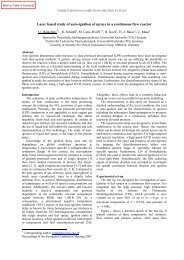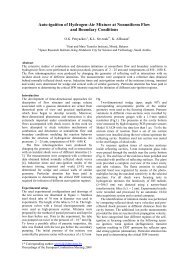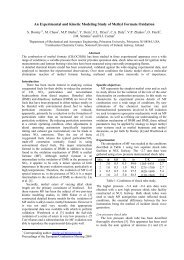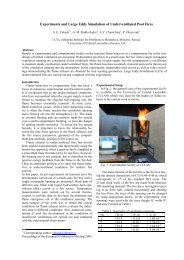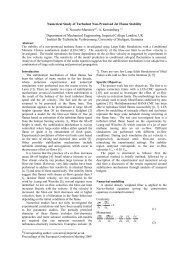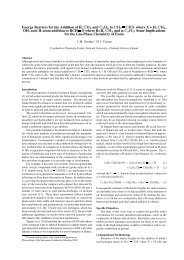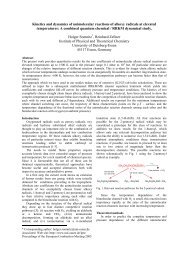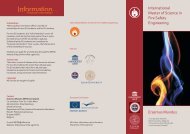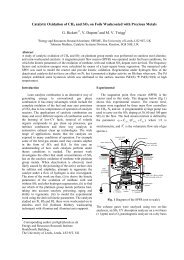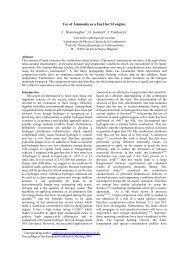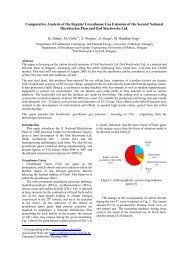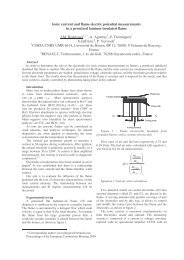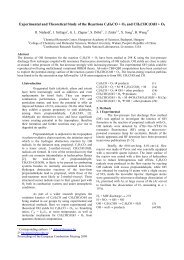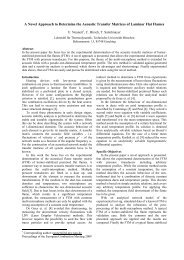Plasma Assisted Combustion Technologies Matveev, S. Matveeva, E
Plasma Assisted Combustion Technologies Matveev, S. Matveeva, E
Plasma Assisted Combustion Technologies Matveev, S. Matveeva, E
You also want an ePaper? Increase the reach of your titles
YUMPU automatically turns print PDFs into web optimized ePapers that Google loves.
<strong>Plasma</strong> <strong>Assisted</strong> <strong>Combustion</strong> <strong>Technologies</strong><br />
<strong>Matveev</strong> ٭1 , S. <strong>Matveev</strong>a 2 , E. Kirchuk 3<br />
1,2,3 Applied <strong>Plasma</strong> <strong>Technologies</strong>, USA<br />
Abstract<br />
This paper provides an overview, classification, and analyzes of the most advanced plasma based technologies<br />
developed mainly to improve ignition reliability, avoid flame instabilities, reduce emissions in a wide variety of<br />
applications, including aerospace propulsion systems, land based power generation units, technological boilers,<br />
furnaces, incinerators, heaters, dryers, etc. The fuel reformation, coal gasification, and waste-into-energy plasma<br />
processing technologies have been also analyzed. The paper shows the most recent and advanced efforts in the<br />
field of plasma assisted combustion and perspective directions for further investigations.<br />
Introduction<br />
Recent progress in research and development of<br />
the plasma based technologies for ignition and<br />
combustion enhancement in propulsion and power<br />
generation systems has led to formation of a new<br />
field of science well known as the plasma assisted<br />
combustion (PAC). With the first known practical<br />
efforts in early 60s of the 20th century the PAC<br />
technologies developers and investigators became<br />
already a well organized community with both annual<br />
conference named International Workshop and<br />
Exhibition on <strong>Plasma</strong> <strong>Assisted</strong> <strong>Combustion</strong><br />
(http://www.plasmacombustion.com/iwepac.html)<br />
and special annual issue under the IEEE Transactions<br />
on <strong>Plasma</strong> Science umbrella<br />
(http://www.ieee.org/portal/site/iportals).<br />
At the moment a list of technologies in the field of<br />
PAC could be divided onto several groups, including<br />
the follows:<br />
• <strong>Plasma</strong> igniters;<br />
• <strong>Plasma</strong> pilots and flame sustainers;<br />
• <strong>Plasma</strong> fuel nozzles;<br />
• Spatial arc;<br />
• Fuel reformers and coal gasifiers;<br />
• Waste-into-energy processing.<br />
Discussion<br />
<strong>Plasma</strong> igniters are the most developed units for<br />
short term operation (up to several minutes) mainly<br />
based on thermal DC torches, RF and MW initiators<br />
[1-12] for sub- and supersonic flows. Over 1,200<br />
plasma ignition systems are in operation worldwide,<br />
including land-based gas turbines and furnaces. They<br />
normally replace spark plugs and have power<br />
consumption from 500W to 1 kW, plasma gas flow<br />
rate up to 1 g/s and lifetime up to 4,000 operating<br />
cycles. The main advantage of a plasma igniter in<br />
comparison to conventional spark plug is in much<br />
higher plasma plume volume and velocity. That<br />
allows deeper penetration of the high reactive plasma<br />
plume into the combustion zone for more reliable<br />
ignition. One of the plasma igniters for industrial gas<br />
turbine in operation is demonstrated in Fig.1.<br />
There are several known approaches for ignition<br />
in high-speed cross flows specifically for the<br />
aerospace propulsion systems and scramjets [1, 7-9,<br />
٭Corresponding author: i.matveev@att.net<br />
Proceedings of the European <strong>Combustion</strong> Meeting 2009<br />
11-12]. Among perspective solutions are<br />
radiofrequency (RF) and microwave (MW<br />
discharges, as far as non-thermal torches with a fuel<br />
feeding into the arc chamber. Recently developed by<br />
Figure 3.<br />
Subcritical<br />
streamer MW<br />
discharge in a<br />
reverse vortex<br />
combustor.<br />
Figure 1.<br />
<strong>Plasma</strong> Igniter<br />
in operation.<br />
Applied <strong>Plasma</strong> <strong>Technologies</strong> (APT) supersonic<br />
torch based on transient glow to spark discharge is<br />
shown in Fig.2 [9].<br />
Figure 2. Supersonic <strong>Plasma</strong> Igniter.<br />
<strong>Plasma</strong> pilots and flame sustainers are in the<br />
second group of the plasma<br />
devices with two main<br />
functions – ignition and<br />
continuous flame control<br />
[13-28]. The market needs of<br />
continuously operating in a<br />
high temperature<br />
environment with variable<br />
pressure pilots and flame<br />
holders have moved<br />
researches to development of<br />
a non-thermal plasma<br />
sources with significantly<br />
extended lifetime and less<br />
power consumption, pulse<br />
power devices, direct arc<br />
initiators, and MW initiators.<br />
Known plasma pilots operate<br />
within the averaged power
ange up to 300-500 W, at pressure by 10-15 bar, and<br />
provide continuous operation by 1,000 running hours.<br />
One of the most perspective MW systems for ignition<br />
and flame control in a reverse vortex combustors has<br />
been developed by Moscow Radio Technical Institute<br />
[27] and is presented in Fig.3.<br />
<strong>Plasma</strong> fuel nozzle as a combination of plasma<br />
generator and fuel atomizer with simultaneous fuel<br />
atomizing, ignition and flame control in one unit is<br />
the most complicated and advanced plasma assisted<br />
combustion solution. Several experimental nozzles<br />
for gaseous and liquid fuels with a flexi-fuel<br />
operation and steam feeding are under development<br />
in APT. The main advantages of these nozzles are:<br />
(a) dramatically increased ignition reliability, (b)<br />
much wider equivalence ratio or lambda range, (c)<br />
significant decrease in T4 (RIT) jump at the point of<br />
fuel ignition, (d) utilization as a pilot burner, (e)<br />
utilization for hydrogen enriched gas generation, (f)<br />
reduction of a combustion zone geometry, (g)<br />
reduction of the combustion chamber walls<br />
temperature, (h) increase of a combustion efficiency<br />
(COP), (i) achieving smokeless operation, (j)<br />
simultaneous burning of several fuels, (k) smooth<br />
regulation in a wider turn down ratio. One of a<br />
plasma nozzle samples for gaseous fuel burning in a<br />
gas turbine is provided in Fig.4.<br />
Figure 4. <strong>Plasma</strong> fuel nozzle for<br />
gaseous fuels appearance.<br />
Spatial arc is one of the recently patented by APT<br />
[38] applications of a non-thermal high voltage<br />
discharge in a form of orbiting inside a combustion<br />
chamber source of ignition and flame control.<br />
Employing the combustor walls as the electrodes, this<br />
arc with averaged power consumption from 10W to 1<br />
kW provides simple and energy efficient solution for<br />
gas fired furnaces and combustors, particularly leanburned<br />
ones [29, 30]. One of the lab-scale combustor<br />
prototypes with low power spatial arc is provided in<br />
Fig. 5.<br />
2<br />
Figure 5. Reverse vortex combustor with<br />
10W spatial arc.<br />
Fuel reformers and coal gasifiers.<br />
There are numerous publications devoted to fuel<br />
reformation [31-44] and coal gasification [45-55].<br />
The authors have provided just a portion of the recent<br />
ones, which disclose the most marketable approaches<br />
and solutions. It could be seen from the published<br />
manuscripts analyzes that the main obstacle on the<br />
way of the full-scale gasification technologies<br />
development and implementation is absence of the<br />
energy efficient plasma sources with affordable<br />
lifetime and operation costs. For example, existing<br />
coal ignition and partial gasification technology [46,<br />
51] employs 100-200 kW DC torches with limited by<br />
200 running hours cathode lifetime. Similar situation<br />
is with all other plasma torches on the market. It<br />
means that any progress in this direction will be<br />
caused by development of a new generation of high<br />
power atmospheric pressure plasma sources and<br />
power supplies. Based on known plasma generation<br />
solutions analyzes the authors have selected for<br />
further development and implementation a hybrid<br />
type (RF + DC) plasma torch with reverse vortex<br />
flow [30-32], which could provide the atmospheric<br />
pressure plasma reactors operation in combination<br />
with the solid state power supplies. Such a solution<br />
allows unlimited lifetime of both electrical and<br />
plasma generation modules and high caloric value of<br />
a syngas as a final product based on oxygen<br />
gasification process also based on recently developed<br />
air separation technology. The maximum achieved<br />
power level per unit is 1.8MW and expected 10MW.<br />
Waste-into-energy processing is vital for developed<br />
countries, but still not feasible for many of them due<br />
to high cost of ownership and operation expenses for<br />
existing plants and absence of the high productivity<br />
ones with capacity over 250 tons per day. Significant<br />
reduction of the operation costs could be achieved<br />
by: (1) application of a hybrid (RF + DC) torches<br />
with dramatically extended lifetimes, (2) introduction<br />
of a plasma gasification in the oxygen or oxygen-rich<br />
environment, (3) syngas treatment in a steam catalyst<br />
converter to increase a hydrogen yield, and (4) multifeedstock<br />
operation to process any waste from scrap<br />
tires and MSW to coal and electronic waste [31, 32,<br />
40, 41, 55]. Possible integration of the MSW modules
with the coal fired utility power plants will help in<br />
cost of the ownership reduction and minimizing<br />
emissions, including dioxins and furans.<br />
Performed by APT feasibility study of such a<br />
waste-into-energy technology implementation in a<br />
city of Austin, Texas with population about 775,000<br />
residents, annual amount of generated waste of<br />
594,220 tones, tipping fee per household $25 per<br />
month, and cost of waste processing facilities $350<br />
million has shown expected return on investment<br />
from 4 to 5 years, depending on the generated<br />
electricity export price.<br />
In case of all annually generated by the USA<br />
MSW processing net power output could be up to<br />
326 million MW. That could cover over 6% of the<br />
U.S. power demand. Existing landfills recycling will<br />
give additional 1 to 5%. The estimated program cost<br />
based on equipment ownership price is about $90<br />
billion dollars.<br />
Conclusion<br />
Progress is plasma generation, industrial and<br />
societal demand have led to development and<br />
worldwide implementation of a variety of plasma<br />
based technologies, including that ones for<br />
combustion enhancement, fuel reformation, and<br />
gasification.<br />
<strong>Plasma</strong> <strong>Assisted</strong> <strong>Combustion</strong> is a new fast<br />
growing field of science, from one hand side<br />
stimulates progress in such areas as plasma physics,<br />
electronics, material science, and from the other side<br />
provides extraordinary opportunities to make a<br />
progress in propulsion, power generation,<br />
environment protection, etc.<br />
References<br />
[1] I. <strong>Matveev</strong>, "Multi-mode <strong>Plasma</strong> Igniters and Pilots for<br />
Aerospace and Industrial Applications", 2-nd Int. Workshop<br />
and Exhibition on <strong>Plasma</strong> <strong>Assisted</strong> <strong>Combustion</strong>, Falls<br />
Church, Virginia, pp. 12, 2006.<br />
[2] K. Busby, S. Williams, J. Corrigan, C. Cathey, C. Carter, M.<br />
Gundersen, S.T. Yu, F. Schuaer, “Performance of Spark<br />
Ignition in Pulse Detonation Engines”, 2-nd Int. Workshop<br />
and Exhibition on <strong>Plasma</strong> <strong>Assisted</strong> <strong>Combustion</strong>, Falls<br />
Church, Virginia, pp. 14, 2006.<br />
[3] K. Busby, C. Carter, “Spark Ignition for Scramjets”, 2-nd Int.<br />
Workshop and Exhibition on <strong>Plasma</strong> <strong>Assisted</strong> <strong>Combustion</strong>,<br />
Falls Church, Virginia, pp. 13, 2006.<br />
[4] D. Medvedev, G. Konovalova, S. Zaitsev, V. Jivotov, M.<br />
Krotov, A. Borisov, S. Korobtsev, B. Potapkin, A. Dean,<br />
“Detonation Initiation by Pulse Corona Discharge”, 2-nd Int.<br />
Workshop and Exhibition on <strong>Plasma</strong> <strong>Assisted</strong> <strong>Combustion</strong>,<br />
Falls Church, Virginia, pp. 15-17, 2006.<br />
[5] Pancheshnyi, S. V.; Lacoste, D. A.; Bourdon, A.; Laux, C.<br />
O., “Ignition of Propane–Air Mixtures by a Repetitively<br />
Pulsed Nanosecond Discharge.” IEEE Trans. <strong>Plasma</strong> Sci. 34<br />
(6), pp. 2478-2487, Dec. 2006.<br />
[6] Cathey, C.D.; Tao Tang; Shiraishi, T.; Urushihara, T.; Kuthi,<br />
A.; Gundersen, M.A., “Nanosecond <strong>Plasma</strong> Ignition for<br />
Improved Performance of an Internal <strong>Combustion</strong> Engine.”<br />
IEEE Trans. <strong>Plasma</strong> Sci. 35 (6), pp. 1664-1668, Dec. 2007.<br />
[7] Do, H.; Mungal, M. G.; Cappelli, M. A.,“Jet Flame Ignition<br />
in a Supersonic Crossflow Using a Pulsed Nonequilibrium<br />
<strong>Plasma</strong> Discharge.”IEEE Trans. <strong>Plasma</strong> Sci. 36 (6), pp.<br />
2918-2923, Dec. 2008.<br />
3<br />
[8] Davydov, A. M.; Gritsinin, S. I.; Kossyi, I. A.; Shikhman, Y.<br />
M.; Vinogradov, V. A., “Application of MW <strong>Plasma</strong><br />
Generator for Ignition of Kerosene/Air Mixture.” IEEE<br />
Trans. <strong>Plasma</strong> Sci. 36 (6), pp. 2909-2917, Dec. 2008.<br />
[9] I. <strong>Matveev</strong>, E. Kirchuk, “Development and Preliminary Test<br />
Results of the Supersonic <strong>Plasma</strong> Igniter”, 4-th Int. Workshop<br />
and Exhibition on <strong>Plasma</strong> <strong>Assisted</strong> <strong>Combustion</strong>, Falls<br />
Church, Virginia, pp. 26-28, 2008.<br />
[10] V. Bychkov, D. Bychkov, I. Kochetov, “Air-propane Mixture<br />
Ionization for Optimization of Ignition at Application of Gas<br />
Discharges”, 4-th Int. Workshop and Exhibition on <strong>Plasma</strong><br />
<strong>Assisted</strong> <strong>Combustion</strong>, Falls Church, Virginia, pp. 29-31,<br />
2008.<br />
[11] A. Klimov, I. Moralev, B. Tolkunov, I. <strong>Matveev</strong>, “<strong>Plasma</strong><br />
<strong>Assisted</strong> Ignition and <strong>Combustion</strong> of Hydrocarbon Fuel in<br />
High-Speed Air Flow by HF Streamer Discharge”, 4-th Int.<br />
Workshop and Exhibition on <strong>Plasma</strong> <strong>Assisted</strong> <strong>Combustion</strong>,<br />
Falls Church, Virginia, pp. 32-33, 2008.<br />
[12] B. Yefimov, A. Kuleshov, M. Khorunzhenko, “Excitation of<br />
the Microwave Torch Discharge in a Single Conductor Line”,<br />
4-th Int. Workshop and Exhibition on <strong>Plasma</strong> <strong>Assisted</strong><br />
<strong>Combustion</strong>, Falls Church, Virginia, pp. 49-52, 2008.<br />
[13] Korolev, Yu. D.; <strong>Matveev</strong>, I. B., “Nonsteady-State Processes<br />
in a <strong>Plasma</strong> Pilot for Ignition and Flame Control.” IEEE<br />
Trans. <strong>Plasma</strong> Sci. 34 (6), pp. 2507-2513, Dec. 2006.<br />
[14] L. Rosocha, Y. Kim, S. Abbate, R. Sanchez-Gonzalez, “Non-<br />
Thermal <strong>Plasma</strong>-<strong>Assisted</strong> <strong>Combustion</strong> Research in Los<br />
Alamos”, 2-nd Int. Workshop and Exhibition on <strong>Plasma</strong><br />
<strong>Assisted</strong> <strong>Combustion</strong>, Falls Church, Virginia, pp. 19-21,<br />
2006.<br />
[15] Pilla, G.; Galley, D.; Lacoste, D. A.; Lacas, F.; Veynante, D.;<br />
Laux, C. O., “Stabilization of a Turbulent Premixed Flame<br />
Using a Nanosecond Repetitively Pulsed <strong>Plasma</strong>.” IEEE<br />
Trans. <strong>Plasma</strong> Sci. 34 (6), pp. 2471-2477, Dec. 2006.<br />
[16] Esakov, I. I.; Grachev, L. P.; Khodataev, K. V.; Vinogradov,<br />
V. A.; Van Wie, D. M., “Propane–Air Mixture <strong>Combustion</strong><br />
<strong>Assisted</strong> by MW Discharge in a Speedy Airflow.” IEEE<br />
Trans. <strong>Plasma</strong> Sci. 34 (6), pp. 2497-2506, Dec. 2006.<br />
[17] Leonov, S. B.; Yarantsev, D. A.; Napartovich, A. P.;<br />
Kochetov, I. V., “<strong>Plasma</strong>-<strong>Assisted</strong> <strong>Combustion</strong> of Gaseous<br />
Fuel in Supersonic Duct.” IEEE Trans. <strong>Plasma</strong> Sci. 34 (6),<br />
pp. 2514-2525, Dec. 2006.<br />
[18] Kim, Y.; Ferreri, V. W.; Rosocha, L. A.; Anderson, G. K.;<br />
Abbate, S.; Kim, K.-T., “Effect of <strong>Plasma</strong> Chemistry on<br />
Activated Propane/Air Flames.” IEEE Trans. <strong>Plasma</strong> Sci. 34<br />
(6), pp. 2532-2536, Dec. 2006.<br />
[19] Kuo, S. P.; Rubinraut, M.; Popovic, S.; Bivolaru, D.,<br />
“Characteristic Study of a Portable Arc Microwave <strong>Plasma</strong><br />
Torch.” IEEE Trans. <strong>Plasma</strong> Sci. 34 (6), pp. 2537-2544, Dec.<br />
2006.<br />
[20] V. Bychkov, I. Esakov, L. Grachev, K. Khodataev, A.<br />
Lomteva, “A Formulation of Experiments on Propane<br />
Injection to Longitudinal DC Discharge in a Supersonic Air<br />
Flow”, 2-nd Int. Workshop and Exhibition on <strong>Plasma</strong><br />
<strong>Assisted</strong> <strong>Combustion</strong>, Falls Church, Virginia, pp. 26-28,<br />
2006.<br />
[21] S. H. Won, S. K. Ryu, M.S. Cha, Y.H. Song, S.H. Chung,<br />
“Observations on Enhansement of Propagation Speed of<br />
Tribrachial Flames through Electric Fields”, 2-nd Int.<br />
Workshop and Exhibition on <strong>Plasma</strong> <strong>Assisted</strong> <strong>Combustion</strong>,<br />
Falls Church, Virginia, pp. 29, 2006.<br />
[22] Esakov, I.I.; Grachev, L.P.; Khodataev, K.V.; Bychkov, V.L.;<br />
Van Wie, D.M., “Surface Discharge in a Microwave Beam.”<br />
IEEE Trans. <strong>Plasma</strong> Sci. 35 (6), pp. 1658-1663, Dec. 2007.<br />
[23] <strong>Matveev</strong>, I., <strong>Matveev</strong>a, S., Korolev, Y., Frants, O., Landl, N.,<br />
“A Multi-Mode <strong>Plasma</strong> Pilot”, 45th AIAA Aerospace<br />
Sciences Meeting and Exhibit, Reno, Nevada, AIAA-2007-<br />
822, pp. 1-6, 2007.<br />
[24] Korolev, Y.D.; Frants, O.B.; Landl, N.V.; Geyman, V.G.;<br />
<strong>Matveev</strong>, I.B., “Glow-to-Spark Transitions in a <strong>Plasma</strong><br />
System for Ignition and <strong>Combustion</strong> Control.” IEEE Trans.<br />
<strong>Plasma</strong> Sci. 35 (6), pp. 1651-1657, Dec. 2007.<br />
[25] I. Esakov, L. Grachev, K. Khodataev, V. Bychkov,<br />
“<strong>Combustion</strong> of Lean Gaseous Fuel Mixture Stimulated by a<br />
Microwave Discharge”, 3-rd Int. Workshop and Exhibition
on <strong>Plasma</strong> <strong>Assisted</strong> <strong>Combustion</strong>, Falls Church, Virginia, pp.<br />
48-50, 2007.<br />
[26] C. Carter, S. Leonov, “<strong>Plasma</strong> <strong>Assisted</strong> <strong>Combustion</strong> and<br />
Flameholding in High-Speed Flow”, 3-rd Int. Workshop and<br />
Exhibition on <strong>Plasma</strong> <strong>Assisted</strong> <strong>Combustion</strong>, Falls Church,<br />
Virginia, pp. 51-53, 2007.<br />
[27] K. Alexandrov, V. Bychkov, L. Grachev, I. Esakov, K.<br />
Khodataev, A. Ravaev, I. <strong>Matveev</strong>, “Subcritical Streamer<br />
Microwave Discharge in Reverse Vortex <strong>Combustion</strong><br />
Chamber”, 3-rd Int. Workshop and Exhibition on <strong>Plasma</strong><br />
<strong>Assisted</strong> <strong>Combustion</strong>, Falls Church, Virginia, pp. 33-36,<br />
2007.<br />
[28] I. <strong>Matveev</strong>, S. <strong>Matveev</strong>a, S. Serbin, “Triple Vortex <strong>Plasma</strong><br />
<strong>Assisted</strong> Combustor”, 4-th Int. Workshop and Exhibition on<br />
<strong>Plasma</strong> <strong>Assisted</strong> <strong>Combustion</strong>, Falls Church, Virginia, pp. 22-<br />
25, 2008.<br />
[29] H. Maciel, A. Filho, P. Lacava, “Characterization of a<br />
<strong>Combustion</strong> Chamber Operation Supported by a Gliding Arc<br />
<strong>Plasma</strong> Source”, 2-nd Int. Workshop and Exhibition on<br />
<strong>Plasma</strong> <strong>Assisted</strong> <strong>Combustion</strong>, Falls Church, Virginia, pp. 22-<br />
23, 2006.<br />
[30] I. <strong>Matveev</strong>, S. Serbin, A. Mostipanenko, “CFD Investigations<br />
of Spatial Arc Kinetic Influence on Fuel Burning-out in the<br />
Tornado Combustor”, 2-nd Int. Workshop and Exhibition on<br />
<strong>Plasma</strong> <strong>Assisted</strong> <strong>Combustion</strong>, Falls Church, Virginia, pp. 24-<br />
25, 2006.<br />
[31] S. Zverev, D. Ivanov, V. Frolov, I. <strong>Matveev</strong>, “Experimental<br />
Investigations of the Hybrid <strong>Plasma</strong> Torch with Reverse<br />
Vortex Stabilization”, 4-th Int. Workshop and Exhibition on<br />
<strong>Plasma</strong> <strong>Assisted</strong> <strong>Combustion</strong>, Falls Church, Virginia, pp. 39-<br />
44, 2008.<br />
[32] I. <strong>Matveev</strong>, S. Serbin, “Experimental Investigation of the<br />
Hybrid Type <strong>Plasma</strong> <strong>Assisted</strong> <strong>Combustion</strong> and Reformation<br />
System”, 4-th Int. Workshop and Exhibition on <strong>Plasma</strong><br />
<strong>Assisted</strong> <strong>Combustion</strong>, Falls Church, Virginia, pp. 64-67,<br />
2008.<br />
[33] I. <strong>Matveev</strong>, S. Serbin, K. Serbina, “Theoretical Investigation<br />
of the Physical and Chemical Processes in a Liquid Fuel<br />
<strong>Plasma</strong> <strong>Assisted</strong> Reformer”, 4-th Int. Workshop and<br />
Exhibition on <strong>Plasma</strong> <strong>Assisted</strong> <strong>Combustion</strong>, Falls Church,<br />
Virginia, pp. 26-28, 2008.<br />
[34] H-J. Lee, V. Riaby, V. Plaksin, Y.S. Mok, “Fuel Reformation<br />
with a <strong>Plasma</strong>tron of High Activation Ability”, 2-nd Int.<br />
Workshop and Exhibition on <strong>Plasma</strong> <strong>Assisted</strong> <strong>Combustion</strong>,<br />
Falls Church, Virginia, pp. 41, 2006.<br />
[35] Y. Kim, S. Abbate, G. Anderson, R. Sanchez-Gonzalez, L.<br />
Rosocha, H. Ziock, “Combustible Gas Production by <strong>Plasma</strong><br />
Catalyzed Coal Gasification”, 2-nd Int. Workshop and<br />
Exhibition on <strong>Plasma</strong> <strong>Assisted</strong> <strong>Combustion</strong>, Falls Church,<br />
Virginia, pp. 42, 2006.<br />
[36] Sanchez-Gonzalez, R.; Yongho Kim; Rosocha, L.A.; Abbate,<br />
S., “Methane and Ethane Decomposition in an Atmospheric-<br />
Pressure <strong>Plasma</strong> Jet.” IEEE Trans. <strong>Plasma</strong> Sci. 35 (6), pp.<br />
1669-1676, Dec. 2007.<br />
[37] Yongho Kim; Abbate, S.; Ziock, H.; Anderson, G.K.;<br />
Rosocha, L.A., “Hydrogasification of Carbon in an<br />
Atmospheric Pressure Microwave <strong>Plasma</strong>.” IEEE Trans.<br />
<strong>Plasma</strong> Sci. 35 (6), pp. 1677-1681, Dec. 2007.<br />
[38] I. <strong>Matveev</strong>, Applied <strong>Plasma</strong> <strong>Technologies</strong>, U.S. Patent<br />
7,452,513 B2 “Triple Helical Flow Vortex Reactor”, Nov.18,<br />
2008.<br />
[39] I. <strong>Matveev</strong>, Applied <strong>Plasma</strong> <strong>Technologies</strong>, U.S. Patent<br />
Application for a “Power Plant and Method Using a Triple<br />
Helical Vortex Reactor”, 11/309644, filed 05 April, 2007.<br />
[40] I. <strong>Matveev</strong>, S. Serbin, "Preliminary Design and CFD<br />
Modeling of a 1 MW Hybrid <strong>Plasma</strong> Torch for Waste<br />
4<br />
Destruction and Coal Gasification", 2-nd Int. Workshop and<br />
Exhibition on <strong>Plasma</strong> <strong>Assisted</strong> <strong>Combustion</strong>, Falls Church,<br />
Virginia, pp. 43–44, 2006.<br />
[41] <strong>Matveev</strong>, I.B., Serbin, S.I., Lux, S.M., “Efficiency of a<br />
Hybrid-Type <strong>Plasma</strong>-<strong>Assisted</strong> Fuel Reformation System”,<br />
IEEE Trans. <strong>Plasma</strong> Sci. 36 (6), pp. 2940-2946, 2008.<br />
[42] Plaksin, V.Yu.; Heon Ju Lee; Riaby, V.A., “The Effect of<br />
Component Gas on Diesel Reformation by a <strong>Plasma</strong>tron.”<br />
IEEE Trans. <strong>Plasma</strong> Sci. 35 (6), pp. 1617-1621, Dec. 2007.<br />
[43] T.L.Wright. “Coal Gasification – Back to the Future? –<br />
Perspective on Atmospheric vs Pressurized Coal<br />
Gasification.” Proc. 28 Int. Techn. Conf. on Coal Utilization<br />
and Fuel Systems, Clearwater, Florida, USA, Published by<br />
U.S. Department of Energy & Coal Technology Association<br />
of USA, 2003, CD 241-248.<br />
[44] S.V. Dighe, D.E. Lazzara. “Westinghouse <strong>Plasma</strong><br />
Gasification Technology.” Pittsburgh Coal Conference,<br />
Pittsburgh, USA, September 2002.<br />
[45] 3. Jieshan Qiu, Xiaojun He, Tianjun Sun, Zongbin Zhao,<br />
Ying Zhou, Shuhong Guo, Jialiang Zhang, Tengcai Ma.<br />
“Coal gasification in steam and air medium under plasma<br />
conditions: a preliminary study.” Fuel Processing<br />
Technology, 85, pp.969– 982, 2004.<br />
[46] Gorokhovski, M., Karpenko, E.I., Lockwood, F.C., Messerle,<br />
V.E., Trusov, B.G., Ustimenko, A.B., “<strong>Plasma</strong> <strong>Technologies</strong><br />
for Solid Fuels: Experiment and Theory”, Journal of the<br />
Energy Institute, 78 (4), pp. 157-171, 2005.<br />
[47] I. <strong>Matveev</strong>, S. <strong>Matveev</strong>a, V. Messerle, A. Ustimenko, S.<br />
Serbin, “Bituminous Coal <strong>Plasma</strong> Gasification”, 3-rd Int.<br />
Workshop and Exhibition on <strong>Plasma</strong> <strong>Assisted</strong> <strong>Combustion</strong>,<br />
Falls Church, Virginia, pp. 25-26, 2007.<br />
[48] M. Kim, “On-Board Fuel Reforming for Better <strong>Combustion</strong><br />
and Exhaust Emissions in the Internal <strong>Combustion</strong> Engine”,<br />
3-rd Int. Workshop and Exhibition on <strong>Plasma</strong> <strong>Assisted</strong><br />
<strong>Combustion</strong>, Falls Church, Virginia, pp. 30-32, 2007.<br />
[49] V. Chernyak et al, “<strong>Plasma</strong> Production of Hydrogen-<br />
Enriched Gases from Ethanol”, 3-rd Int. Workshop and<br />
Exhibition on <strong>Plasma</strong> <strong>Assisted</strong> <strong>Combustion</strong>, Falls Church,<br />
Virginia, pp. 33-36, 2007.<br />
[50] I.B. <strong>Matveev</strong>, S.I. Serbin, “Modeling of the Coal Gasification<br />
Processes in a Hybrid <strong>Plasma</strong> Torch”. IEEE Trans. <strong>Plasma</strong><br />
Sci., 35 (6), pp.1639–1647, Dec. 2007.<br />
[51] A.S. Askarova, E.I. Karpenko, Y.I. Lavrishcheva, V.E.<br />
Messerle, A.B. Ustimenko. “<strong>Plasma</strong>-Supported Coal<br />
<strong>Combustion</strong> in Boiler Furnace.” IEEE Trans. <strong>Plasma</strong> Sci. 35<br />
(6), pp.1607–1616, Dec. 2007.<br />
[52] I.B. <strong>Matveev</strong>, V.E. Messerle, A.B. Ustimenko. “<strong>Plasma</strong><br />
Gasification of Coal in Different Oxidants.” IEEE Trans.<br />
<strong>Plasma</strong> Sci., 36 (6), pp. 2947-2954, Dec. 2008.<br />
[53] A. Filho, H. Maciel, G. Petraconi, A. Sobrinho, P. Lacava, R.<br />
Pessoa, J. Sagas, “Studies of <strong>Plasma</strong> <strong>Assisted</strong> Coal<br />
Gasification for Syngas Production”, 4-th Int. Workshop and<br />
Exhibition on <strong>Plasma</strong> <strong>Assisted</strong> <strong>Combustion</strong>, Falls Church,<br />
Virginia, pp. 78-79, 2008.<br />
[54] Carabin, P., Gagnon, J-R., “<strong>Plasma</strong> Gasification and<br />
Vitrification of Ash-Conversion of Ash into Glass-like<br />
Products and Syngas”, 2007 World of Coal Ash (WOCA),<br />
Covington, Kentucky, pp. 1-11, 2007.<br />
[55] I. <strong>Matveev</strong>, “Alternative Solutions for MSW-To-Energy<br />
Processing”, 4-th Int. Workshop and Exhibition on <strong>Plasma</strong><br />
<strong>Assisted</strong> <strong>Combustion</strong>, Falls Church, Virginia, pp. 84, 2008.



